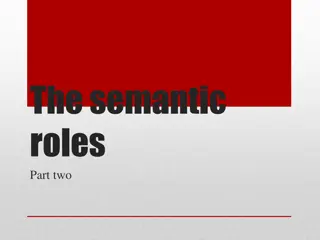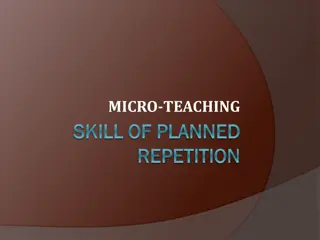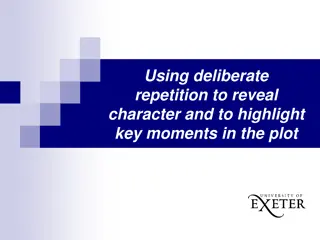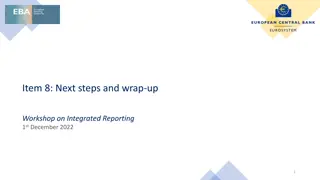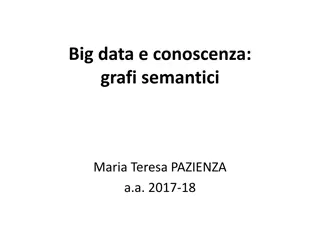Understanding Semasiology: The Study of Word Meaning
Semasiology is a branch of linguistics focused on the meaning of words. It delves into various aspects of lexical meaning, semantic development, polysemy, and semantic structure. Through exploring types of word meanings and semantic changes, semasiology helps us comprehend the intricate nuances of l
4 views • 19 slides
Understanding Semantic Memory Models in Cognitive Psychology
Explore the structure and processes of semantic memory through traditional and neural network views. Delve into symbolic and network models, such as Collins & Quillian's 1970 model, which organize concepts as nodes and links, depicting relationships between concepts within semantic memory representa
1 views • 78 slides
Understanding Semantic Roles in Linguistics
Semantic roles, also known as theta roles, play a crucial part in understanding the relationships between participants and verbs in a sentence. They include agents, experiencers, causers, positioners, subject complements, and objects. Agents are typically the doers of actions, experiencers receive e
1 views • 18 slides
Enhancing Learning Through Planned Repetition in Micro-Teaching
Planned repetition is a valuable skill in micro-teaching that involves repeating and emphasizing important concepts to clarify and reinforce ideas, key words, principles, and concepts. By using simple, spaced, and cumulative repetition techniques, teachers can direct students' attention effectively,
0 views • 15 slides
Understanding Semantic Roles in Sentence Structure
Semanticists analyze sentences based on semantic structure rather than traditional syntactic terms like subject and object. Instead, they use semantic terms such as Agent, External causer, Instrument, Affected, Recipient, and Locative. These terms help describe how people and things participate in r
1 views • 26 slides
Exploring the Audio-Lingual Method in Language Teaching
The Audio-Lingual Method is an oral-based approach that focuses on drilling students in grammatical sentence patterns through behavioral psychology principles. This method, also known as the Michigan Method, emphasizes habit formation and uses techniques like dialogues, repetition drills, and role-p
1 views • 16 slides
Semantic Analysis of Clinical Narratives Using Complex Knowledge Graphs
Need for improved semantic analysis of clinical narratives for information retrieval and decision support is addressed through the use of complex knowledge graphs. These graphs capture axiomatic descriptions of generalizable truths about entities in the medical domain, providing a language-independe
0 views • 8 slides
Understanding Semantic Properties in Lexical Semantics
Explore the concept of semantic properties in lexical semantics through examples involving word meanings and relationships. Learn how semantic properties form the basic building blocks of language construction, sharing common attributes among words while also showing contrastive distinctions. Dive i
0 views • 17 slides
Evolution of Semantic Field Theory in Linguistics
The theory of semantic fields, also known as field-theory, originated in the 1920s and 1930s with German and Swiss scholars. J. Trier and L. Weisgerber further developed this theory post World War II, associating it with the Language and Society movement. Trier's approach focused on comparing the st
0 views • 20 slides
Exploring Literary Devices in Frances Hodgson Burnett's Work
Frances Hodgson Burnett utilizes various literary devices, such as repetition and alliteration, in her novel "The Secret Garden" to engage readers and convey deeper meanings. Through examples and explanations, this article delves into how repetition and alliteration are employed to enhance the story
0 views • 23 slides
Understanding Compositional Risks in Writing
Explore the concept of compositional risk in writing, where authors strive to create engaging and unique content. Learn about the risks writers take to captivate readers, from using voice, repetition, and figurative language to incorporating humor, sarcasm, and surprise elements. Discover how quirki
2 views • 24 slides
Understanding the Importance of Semantic HTML Tags
In this lecture, we delve into the significance of semantic HTML tags in structuring web content. We explore when to use
2 views • 9 slides
Exploring Semantic Web Technologies: RDFa, GRDDL, and POWDER
Delve into the depths of Semantic Web technologies with a focus on RDFa, GRDDL, and POWDER through the guidance of Dr. Nicholas Gibbins. Learn about embedding Semantic Web data, republishing embedded data, and the usage of GRDDL for XML transformations.
13 views • 38 slides
Understanding Semantic Properties of Verbs in English Language
Explore the semantic properties of English verbs through various examples and classifications. Discover how verbs like hit, kiss, and touch share common properties, while verbs like make, create, imagine, and build belong to different classes based on their semantic relationships. Delve into the gra
0 views • 17 slides
Semantic Web Technologies and Knowledge Representation Overview
Semantic Web technologies such as RDF, RDFS, OWL, and SPARQL form the basis of a web of data designed for machine understanding. Knowledge representation languages play a crucial role in AI, with Semantic Web languages like OWL leading the current generation. Contrasting database and knowledge base
0 views • 50 slides
Dynamic Semantic Parser Approach for Sequential Question Answering
Using a Dynamic Semantic Parser approach, the research focuses on Sequential Question Answering (SQA) by structuring queries based on semantic parses of tables as single-table databases. The goal is to generate structured queries for questions by defining formal query languages and actions for trans
0 views • 23 slides
Exploring Repetition in Texts to Understand Character Development
Delve into the deliberate use of repetition in text to unveil character traits and emphasize key moments in the plot. From establishing learning principles to noticing patterns in authentic texts like Dickens' work, discover how repeated elements serve to reveal character nuances and create impactfu
0 views • 7 slides
Understanding Regulations on Course Repetition in Educational Institutions
Exploring the regulations governing credit course repetition in educational institutions, with insights on past rules, current changes, and guidelines to address repetition issues effectively. Topics covered include enrollment limits, apportionment rules, and the importance of adhering to regulation
0 views • 64 slides
Understanding Semantic Effects in Verbal Short-term Memory
Investigating the impact of semantic knowledge and similarity on verbal short-term memory, this study delves into how imageability of words influences recall. Key findings highlight the influence of semantic relatedness and the imageability effect on memory retention, shedding light on the mechanism
0 views • 47 slides
Unveiling Polarity with Polarity-Inducing Latent Semantic Analysis
Polarity-Inducing Latent Semantic Analysis (PILSA) introduces a novel vector space model that distinguishes antonyms from synonyms. By encoding polarity information, synonyms cluster closely while antonyms are positioned at opposite ends of a unit sphere. Existing models struggle with finer distinct
1 views • 29 slides
Multimodal Semantic Indexing for Image Retrieval at IIIT Hyderabad
This research delves into multimodal semantic indexing methods for image retrieval, focusing on extending Latent Semantic Indexing (LSI) and probabilistic LSI to a multi-modal setting. Contributions include the refinement of graph models and partitioning algorithms to enhance image retrieval from tr
1 views • 28 slides
Exploring Denotative Meaning and Translation Issues in Arabic Language
The article delves into denotative meaning, semantic repetition, synonym/near-synonym repetition, grammatical transposition, and semantic distancing techniques in Arabic language translation. It discusses how Arabic utilizes various forms of repetition and transposition that differ from English, sho
0 views • 15 slides
Semantic Data Model of Electronic Invoicing Core Elements
Presentation by Fred van Blommestein on the EN16931-1 semantic data model of core elements in electronic invoicing, covering invoice processes, core invoice design, semantic model details, business rules, and invoicing principles. The model includes 160 elements in 33 groups, with mandatory elements
0 views • 13 slides
Changes to Course Repetition Policy Fall 2013
The course repetition policy at SMC underwent significant changes in Fall 2013, primarily driven by cost-saving measures in California. The update eliminated repeatable courses in visual and performing arts, cosmetology, and physical education, with few exceptions. Students receiving A, B, C, or P g
0 views • 21 slides
Introduction to Java Control Structures: Repetition
Learn how to implement repetitive algorithms using loops in Java. Practice using boolean expressions, Scanner for user input, and the declaration and use of methods. Explore the three basic control structures: Sequence, Selection, and Repetition. Discover the motivation behind repetition and how to
0 views • 23 slides
Understanding Repetition in Jonathan Edwards' "Sinners in the Hands of an Angry God
Exploring the use of repetition in Jonathan Edwards' classic sermon "Sinners in the Hands of an Angry God," highlighting its significance in emphasizing key points, engaging readers, and creating a sense of unity. Through examples and analysis, the repeated phrases and concepts are examined for thei
0 views • 15 slides
Revisiting Semantic Feature Analysis: A Classic Therapy Technique
Aphasia often involves semantic breakdown, and Semantic Feature Analysis (SFA) is a foundational technique for various treatments addressing semantic impairments. This presentation explores the effectiveness of SFA in improving naming, generalization to spontaneous speech, and treatment goals beyond
0 views • 16 slides
Writing Tips and Techniques for Honors English 10
Enhance your writing skills with these creative techniques for adding humor, poetic rhythms, hyphenated modifiers, and repetition for effect to your paragraphs. Inject humor to keep readers engaged, create magic with three parallel groups of words, and use hyphenated modifiers for sophistication. Ex
0 views • 14 slides
Integrated Reporting Workshop Wrap-Up and Next Steps
The workshop on integrated reporting held on 1st December 2022 focused on enhancing proposals, planning JBRC setup, data dictionary governance, semantic integration, and more. The roadmap for 2023 includes topics like data granularity, governance, and continuous work on semantic and syntactic layers
0 views • 4 slides
Exploring Stylistic Devices: Metaphor, Metonymy, Repetition, and More
Delve into the theory of stylistic devices proposed by V.V. Gurevich, covering figures of speech, structural devices, and phonetic expressive means. Discover examples of metaphors, metonymy, repetition techniques like anaphora and climax, along with their impact on language usage and expression.
0 views • 22 slides
Semantic Relations Expressed by Prepositions in Modeling Study
Explore the study on modeling semantic relations expressed by prepositions conducted by Vivek Srikumar and Dan Roth from the University of Illinois, Urbana-Champaign. The research delves into prepositions triggering relations, ontology of preposition relations, examples of preposition relations, pre
0 views • 25 slides
Understanding Design Principles: Contrast, Repetition, Alignment, Proximity, Color Theory
Explore the significance of design principles such as contrast, repetition, alignment, proximity, and color theory in creating visually appealing and effective designs. Learn how contrast plays a vital role in guiding the viewer's attention and enhancing visual interest through various techniques li
0 views • 30 slides
Ensembling Diverse Approaches to Question Answering
Diverse types of question answering approaches include factoid querying, compositional querying of structured databases/knowledge graphs, reading comprehension, and visual question answering. Limitations of factoid question answering are also discussed, highlighting the need for specific queries and
0 views • 28 slides
Annotating Semantic Issues in Translation for Students
This chapter delves into semantic issues in translation, aiming to assist students in annotating their translations from a semantic viewpoint. It emphasizes using semantic information to aid in translating data accurately while maintaining communicative effectiveness. The story discussed highlights
0 views • 19 slides
Semantic Classification of Prepositions in Bulgarian WordNet: A Comprehensive Overview
This presentation delves into the semantic classification of prepositions in the BulTreeBank WordNet, focusing on the incorporation of prepositions, closed-class words, and the benefits for neural model building in Bulgarian language processing. The motivation behind the study, challenges posed by p
0 views • 7 slides
Semantic Technologies for Data Management and Knowledge Extraction
An exploration of how semantic technologies facilitate data management, knowledge extraction, and understanding in the realm of big data. Topics covered include semantic graphs, content information extraction, and the impact of semantic models on enhancing data value and relationships. The importanc
0 views • 38 slides
Requirements for Semantic Biobanks and Global Biobank Data Retrieval
Explore the critical aspects of semantic interoperability in biobanking, highlighting the need for formal ontologies, comprehensive annotations, and model of meaning data. The (Generalized) Biomedical Retrieval Scenario underscores the importance of effective resource retrieval based on content-base
0 views • 16 slides
Exploring Binary Representation and Semantic Approaches in Data and Programs
Delve into the fascinating realm of binary representation and semantic approaches in data and programs through a series of discussions and examples. Topics include encoding/decoding relevance, tamper-proof bytecode formats, incorporating semantic info for compact encodings, and playing guess-who gam
0 views • 21 slides
Advances in Neural Semantic Parsing
Delve into the realm of neural semantic parsing with a focus on data recombination techniques, traditional parsers, and the shift towards domain-general models. Explore the application of sequence-to-sequence models and attention-based neural frameworks in semantic parsing tasks. Discover the evolvi
0 views • 67 slides
Understanding RDF Schema: A Deep Dive into Semantic Web
In this detailed exploration of RDF Schema, Dr. Nicholas Gibbins covers topics such as defining classes and properties, subclass relationships, semantic implications, reflexive properties, type distribution, and property definitions in RDF. Learn about the essential aspects of RDF Schema and its rol
0 views • 19 slides


